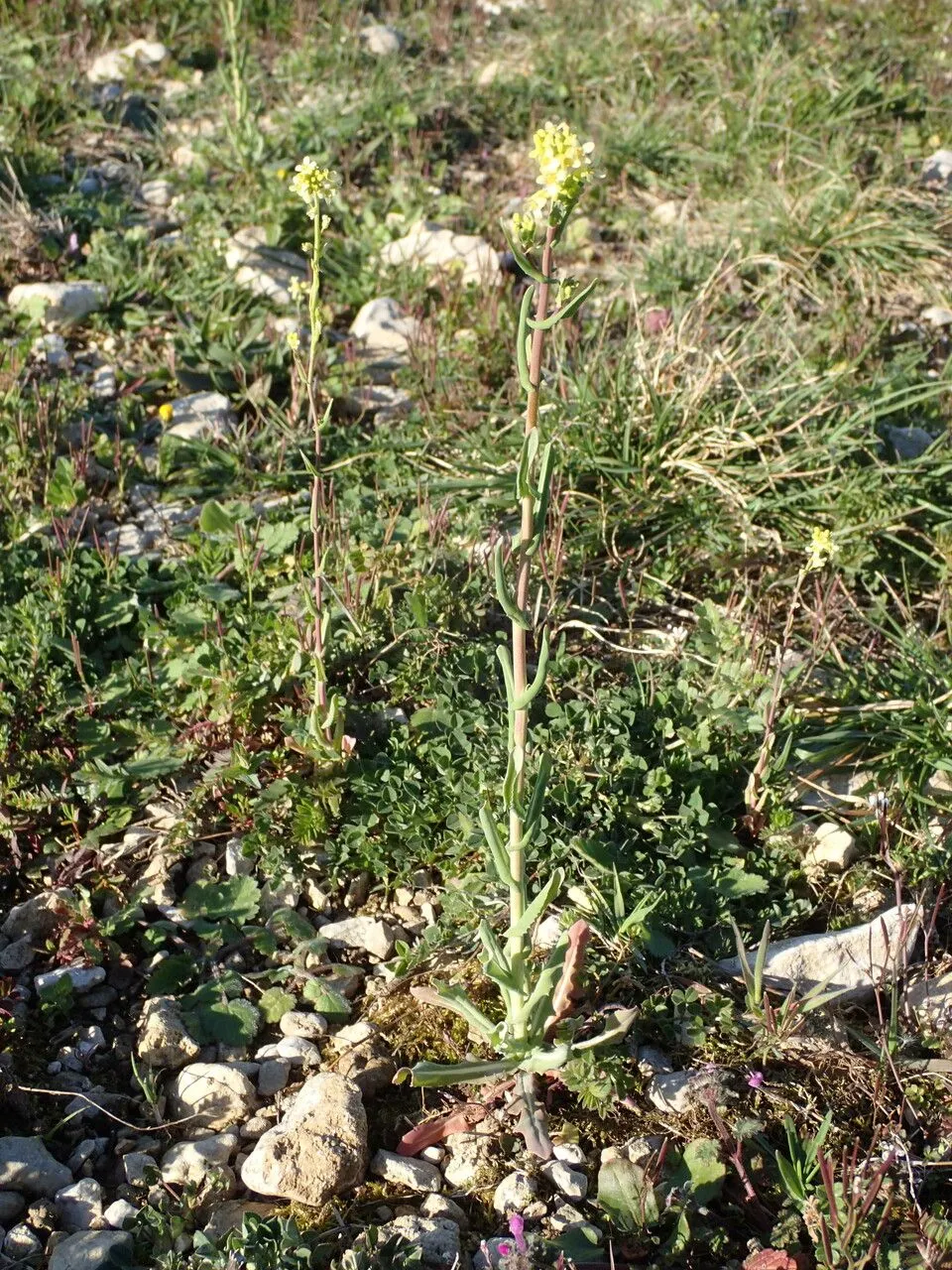
Author: L.
Bibliography: Sp. Pl.: 640 (1753)
Year: 1753
Status: accepted
Rank: species
Genus: Myagrum
Vegetable: False
Observations: Europe to Iran
Mite cress, known scientifically as Myagrum perfoliatum, is a fascinating plant belonging to the Brassicaceae family. This unique species boasts a European origin, extending its habitats as far east as Iran. The mite cress was first described in 1753 by the botanist Carl Linnaeus in his seminal work, “Species Plantarum,” which highlights the foundational details of its taxonomy and characteristics.
This annual herbaceous plant stands out for its distinctive foliage and growth pattern. Mite cress is typically recognized by its perfoliate leaves, which give the appearance of the stem piercing through the leaf blade, a feature that lends a unique charm to the plant’s overall aesthetic. As a member of the mustard family, it shares some common traits with other Brassicaceae members, such as the formation of four-petaled flowers and the production of siliques, which are a type of seed pod.
Mite cress thrives in a variety of environments, often found in meadows, fields, and disturbed soils where it can benefit from ample sunlight and moderate moisture. Its adaptability has allowed it to spread across a broad geographical range, encompassing diverse climatic conditions from the temperate zones of Europe to the more arid regions of Iran.
In terms of ecological interactions, Mite cress plays various roles in its habitat. It serves as a food source for certain insects and helps in maintaining the ecological balance within its ecosystem. Moreover, its seeds can endure tough conditions, enabling the plant to re-establish itself in suitable environments year after year.
While not extensively known for any major economic uses, Mite cress holds intrinsic value to botanists and ecologists studying the biodiversity and plant dynamics within the Brassicaceae family. Its presence in diverse habitats also indicates healthy ecological systems and can serve as a bioindicator for environmental conditions.
Overall, Myagrum perfoliatum captures the interest of nature enthusiasts and scientists alike due to its distinctive botanic characteristics, widespread availability, and the ecological niches it occupies.
Eng: bird’s-eye cress, dog mustard, mite cress, mitre cress, muskweed, mitrecress
Deu: hohldotter
Dan: huldodder
Lit: permautalapis raumenius
Fra: caméline, myagre perfolié, myagre
Est: hiiretudrik
Swe: håldådra
Ces: myšojed prerastenolistý, povázka prorostlá
Lav: skaujlapu miagra
Nld: myagrum
En: Mite cress, Mitre cress, Muskweed, Dog mustard, Bird’s-eye cress, Gold of pleasure, Mitrecress
Cs: Myšojed prerastenolistý, Povázka prorostlá
Da: Huldodder
Nl: Myagrum
Et: Hiiretudrik
Fi: Ontervio
Fr: Caméline, Myagre perfolié, Myagre, Myagrum à feuilles embrassantes
De: Hohldotter, Pfeilblättriger Hohldotter
He: מיאגרון אוזני
It: Miagro liscio
Lv: Skaujlapu miagra
Lt: Permautalapis raumenius
Es: Piques grandes
Sv: Håldådra
Taken May 9, 2022 by eileen doran-smith (cc-by-sa)
Taken Mar 7, 2020 by Sylvain Piry (cc-by-sa)
Taken May 15, 2022 by christophe benvenuto (cc-by-sa)
Taken Apr 14, 2022 by Lars Mannzen (cc-by-sa)
Taken Dec 5, 2020 by alessadro brign (cc-by-sa)
Taken Mar 19, 2015 by EOL − Jim Varnum (cc-by-nc)
Taken Feb 15, 2015 by EOL − Jim Varnum (cc-by-nc)
Taken May 7, 2017 by Tela Botanica − Sylvain PIRY (cc-by-sa)
Taken Mar 7, 2020 by Sylvain Piry (cc-by-sa)
Taken Jun 5, 2014 by Tela Botanica − Marie PORTAS (cc-by-sa)
Taken Jun 2, 2010 by Tela Botanica − Mathieu MENAND (cc-by-sa)
Taken Mar 18, 2015 by EOL − Jim Varnum (cc-by-nc)
Taken Mar 18, 2016 by EOL − Jim Varnum (cc-by-nc)
Taken Apr 16, 2020 by Mehmet Basbag (cc-by-sa)
Taken Mar 7, 2020 by Sylvain Piry (cc-by-sa)
Taken May 15, 2003 by Photoflora – Jean-Luc TASSET (©)
Taken May 7, 2017 by Tela Botanica − Sylvain PIRY (cc-by-sa)
Taken May 7, 2017 by Tela Botanica − Sylvain PIRY (cc-by-sa)
Taken Jan 1, 1970 by Photoflora – L’Abbé COSTE (©)
Taken May 15, 2014 by Photoflora – Benoit BOCK (©)
© copyright of the Board of Trustees of the Royal Botanic Gardens, Kew.
© copyright of the Board of Trustees of the Royal Botanic Gardens, Kew.
© copyright of the Board of Trustees of the Royal Botanic Gardens, Kew.
Taken May 27, 2006 by Tela Botanica − Liliane Roubaudi (cc-by-sa)
Taken Jun 2, 2010 by Tela Botanica − Mathieu MENAND (cc-by-sa)
Taken May 7, 2017 by Tela Botanica − Sylvain PIRY (cc-by-sa)
Taken May 23, 2017 by Tela Botanica − Marie PORTAS (cc-by-sa)
Taken Apr 14, 2022 by Lars Mannzen (cc-by-sa)
Taken Apr 15, 2004 by Photoflora – Benoit BOCK (©)
Taken May 15, 2014 by Photoflora – Benoit BOCK (©)
Taken May 27, 2006 by Tela Botanica − Liliane Roubaudi (cc-by-sa)
Taken May 27, 2006 by Tela Botanica − Liliane Roubaudi (cc-by-sa)
Taken Apr 15, 2008 by Tela Botanica − Mathieu MENAND (cc-by-sa)
Growth habit>: Forb/herb
Ph maximum: 9.0
Ph minimum: 8.0
Light: 7
Atmospheric humidity: 4
Bloom months: [‘may’, ‘jun’, ‘jul’]
Soil nutriments: 5
Family: Myrtaceae Author: (F.Muell.) K.D.Hill & L.A.S.Johnson Bibliography: Telopea 6: 402 (1995) Year: 1995 Status:…
Family: Rubiaceae Author: Pierre ex A.Froehner Bibliography: Notizbl. Bot. Gart. Berlin-Dahlem 1: 237 (1897) Year:…
Family: Sapindaceae Author: Koidz. Bibliography: J. Coll. Sci. Imp. Univ. Tokyo 32(1): 38 (1911) Year:…
Family: Asteraceae Author: A.Gray Bibliography: Pacif. Railr. Rep.: 107 (1857) Year: 1857 Status: accepted Rank:…
Family: Fabaceae Author: Medik. Bibliography: Vorles. Churpfälz. Phys.-Ökon. Ges. 2: 398 (1787) Year: 1787 Status:…
Family: Aspleniaceae Author: (Cav.) Alston Bibliography: Bull. Misc. Inform. Kew 1932: 309 (1932) Year: 1932…